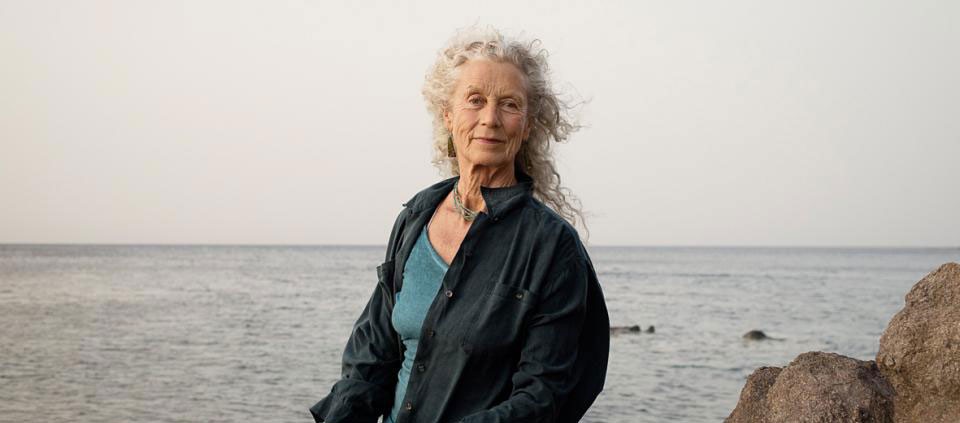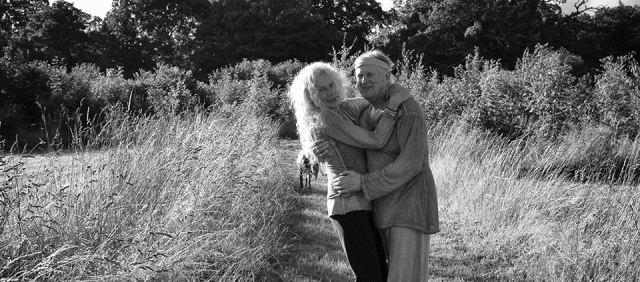Angela Farmer on Yoga, Activism, and Reconnecting with the Body

Angela Farmer, renowned yogi and activist, lives with her husband, Victor van Kooten, on Lesvos, Greece, where they teach courses together and separately in a valley surrounded by olive trees, a five-minute walk from the sea. As refugees from Syria, Afghanistan, Iraq, Palestine, and now also from African countries continue to seek safe harbor on Lesvos, Angela has been teaching yoga classes at refugee camps, and training others to do the same.
Angela will be at Kripalu in November to teach two programs, Becoming Who You Are at Any Age, November 8–10, and Inner Body Activism during Women’s Week, November 10–15. I have long admired Angela’s poise and tenacity in the face of obstacles, whether personal or political. She spoke with me recently from her studio in Lesvos.
Lara How does yoga inform your ongoing work with refugees? And what is happening there at the moment?
Angela We’re in the midst of some real challenges, as the conditions for refugees become worse and worse. They are arriving on fragile and overcrowded rafts, about one thousand a week, from countries at war. The camps are overflowing, and the refugees are living in tents, sleeping like sardines packed tight together. The sanitation is a disaster and the food is terrible—yet, for many, it feels safer than the place they left behind.
Five years ago, when they were landing on the northern beaches on this side of the island, I was able to make some personal connections—helping them off the rafts, and providing food, dry clothing, and sometimes rides to a shelter. Now they arrive on the other side of the island—I must cross two mountain ranges to get there, and my life and teaching schedule leaves little time to make regular visits. So I have been training Maryam, a woman from Afghanistan, to teach yoga. She now teaches in four different refugee centers—for no pay, in difficult conditions—and her students love her. She has full classes, and her students tell her that she takes away their pain and anxieties.
The retreats and courses that I teach on Lesvos and internationally are mostly for people from around the world who have enough money to live comfortably and travel to study and go more deeply into their yoga practice. There is another whole part of the world that doesn’t live like that. So my project and my hope is to link up people I meet who would like to get to know and help one refugee or family directly, rather than send money though a large organization. It’s complicated, of course, but it feels worthwhile.
Lara How do you maintain a sense of balance in your daily life when this crisis is happening nearby?
Angela I feel the pull to this kind of humanitarian work, but what I’ve found is that it is essential to always do my own work first. I have evolved a practice that continues to unveil more layers and offer deeper understanding. It’s a practice that brings me back completely into a place of silence, acceptance, patience, huge gratitude, and amazing joy. This has taken me years to unravel. It’s a personal journey, but one of the principles is universal: Instead of doing, you undo. Even if they don’t realize it, people are looking for rest and unwinding to counterbalance the challenge and speed of modern lifestyles, so they can come back to themselves. The funny thing is that the less I “do” yoga and the more I follow my body into deep, internal unwinding, the more yoga is happening.
Lara You’ve said, “I want yoga to enhance my life, and that means enhancing my life from the inside.” How does that process start? How to you begin to listen to the body and undo?
Angela You start where you are—find one place in your body, a part that is tight or painful or calling to you in some way, and listen to it. Spend time with it in some way. Go inside and see where you can meet it in a very compassionate way—not in an indulgent way, but with understanding. You meet it like you might meet someone who was injured, who has fallen and is crying. You go very slowly and carefully and wait for them to trust you. As you go into one physical part of yourself, it opens up all kinds of other aspects and possibilities in your life—memories, atmospheres, emotions, as well as inspiration and creativity.
In this process, I have discovered that undoing opens up space in my body, and what we really need is space. When we have space in our bodies, we have space in our lives. We breathe better, we can step back into our spaciousness. I spent several years just teaching about the back body, because so much is about going forward—our eyes are in the front, our nose, our mouths; we’re looking, speaking, and moving forward; everybody’s telling you to achieve, to do this or that, that you’re not good enough unless you advance. What we really need is to counterbalance and step back!
When I was in India, I had a vision of a straight and narrow path going up a mountain, and at the top was an emancipated yogi in a cave. He was a man, but he was also me. I was on that stereotypically male path. Then, one early morning at a temple in Orissa [an eastern Indian state on the Bay of Bengal], I saw the sun appearing over the ocean horizon, lighting up figures carved from stone on the temple walls, beautiful feminine deities. My inner voice spoke loudly: They are women, but they are yoginis. I can be a woman and a yogi. That was the beginning of my shift from a male-orientated, achievement-focused style of yoga into finding out what it is to be a feminine yogi. And I had to do it from a place of stillness. It has taken many years and continues to unfold.
Lara When I think of activism, I think of speaking up and speaking out, an outward push, a sense that we must selflessly direct all our energy away from ourselves. But you’re talking about a different approach.
Angela It’s a balance. Activism does come from acting, from going out. But if we only go out, we get off-balance. And if we only do yoga, we also can get off-balance. Inner activism means that when you practice internal healing first, you can go into a situation where people are desperate and bad things are happening, but you have the strength, the compassion, and the tools to help them, because you’ve also spent time inside your own life and your own body.
Yoga requires an acceptance of the body, particularly the parts that have suffered in some way. These injured places in our body don’t trust us anymore. We’ve pushed them and pulled them and probably been annoyed with them. We call them “my bad shoulder,” “my bad hip.” When we let a painful or tight place know, in our own internal way, that we understand it has suffered, that we care for it and accept it in its present situation, however ugly or difficult it is, this can start an amazing communication. Slowly, over time, you build a relationship, so that the fearful or injured part starts to trust you again.
That kind of communication with places in our body is the beginning of activism. Once those places start to open up and you find more internal space, you can give energy to them, and they become more alive. They bring back a part of your life that was missing. That’s when you can stand in your own power and speak your truth with a voice that you did not have before. The part of you that was crumpled up from a very old fear or trauma is open again, and you can live more fully and joyfully in yourself.
Some people have the ability and courage to go straight out into the world and do big things. But I believe that the big things we want to do for others emerge once we face our places inside.
Find out about upcoming programs with Angela Farmer at Kripalu.
Lara Tupper, MFA, is the author of two novels, Off Island and A Thousand and One Nights, and Amphibians, a linked short story collection forthcoming in 2021.
Full Bio and Programs